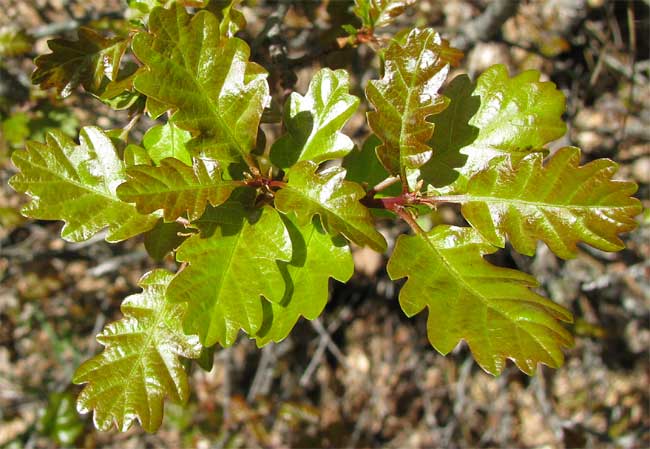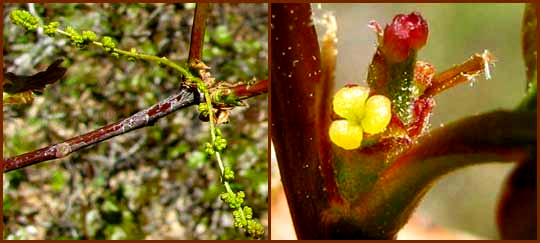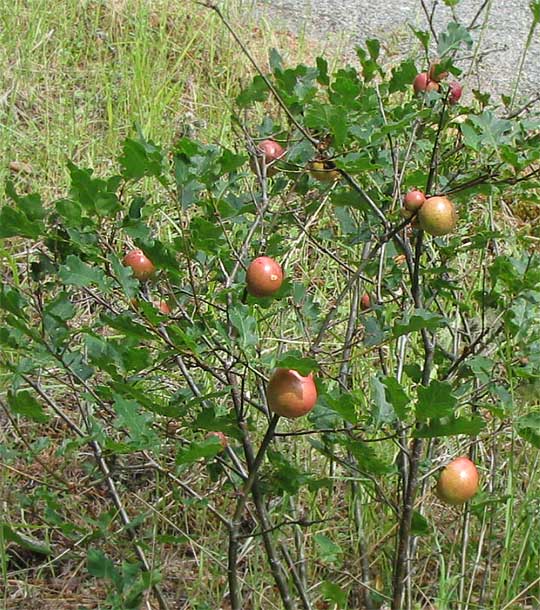Excerpts from Jim Conrad's
Naturalist Newsletter

from the the May 17, 2009 Newsletter, issued from the Siskiyou Mountains west of Grants Pass, Oregon:
QUERCUS GARRYANA x SADLERIANA
When I arrived here and saw that only four oak species were listed for Oregon, and that those species' leaves were easily distinguishable from one another, I thought I had it made in the oak business. And then I took my first long walk.
On certain slopes I found something that was obviously an oak, and obviously in the white oak group, but it was no more than a bush, usually little more than waist high. I've seen bushy oaks in Mexico so finding bushy oaks here was OK with me. But, why wasn't a bushy oak species mentioned in the various lists of Oregon's oak species?
Finally I've figured out that our bushy oak is the QUERCUS GARRYANA var. BREWERII*. The Oregon White Oak, Quercus garryana var. garryana, does indeed appear in all the lists. You can see leaves of the bushy Brewer's Oak above.
Brewer's Oak leaves aren't as deeply lobed as those of typical Oregon White Oak trees. In fact, my impression is that the bush variety has almost evolved to full species status, for often Brewer's Oak bushes mingle with Oregon White Oak trees, and only occasionally do I find intermediate forms. I can't recall seeing a variety maintaining its identify so well while mingling promiscuously with so many of its parent species.
I have a wild theory about how that might be possible. In general aspect, Brewer's Oak bushes nowadays share an uncanny resemblance to leafing-out Poison Oak. At this season those two very unrelated species are about the same size, both are unfolding glossy, reddish-green leaves, and both bear dangling clusters of yellow, pollen-producing male flowers. Of course Poison Oak's leaves are trifoliate while Brewer's Oak's leaves are simple blades, so they're easy to tell apart if you look closely. However, if you're just walking by a thicket with both species, you'll think everything there is Poison Oak, which is by far the most common species. Could it be that the Brewer's Oak variety maintains its identity so well because the bush form for some reason benefits by being so similar to Poison Oak? Maybe deer avoid Poison Oak and consequently leave Brewer's Oak bushes alone as well? What a nice study this would make.

Above you see the Brewer's Oak's catkin-like aments of male flowers on the left and a cluster of female flowers in a leaf axil at the right. The three yellow things among the female flowers are a female flower's three stigma-tipped styles spread wide to receive pollen.
Though the Oregon White Oak parent species is distributed from southern British Columbia deep into California, the Brewer's Oak variety is endemic to our Siskiyou Mountains, possibly with an outlying population in the northern Sierra Nevadas of California.
from the June 21, 2009 Newsletter, issued from the Siskiyou Mountains west of Grants Pass, Oregon:
BREWER'S OAKS & THEIR APPLES
In the May 17th Newsletter I introduced you to our shrub-size Brewer's Oaks, Quercus garryana var. breweri. {see note atop this page.} One of the strangest sights on the landscape right now is these shrubs' big red "apples," as shown below:

Brewer's Oaks are abundant here and they abundantly bear these apples: it's an amazing thing to see. Other oak species also bear them but they're most conspicuous on shrubby Brewer's Oaks. The apples are insect-caused galls created by the tiny wasp ANDRICUS CALIFORNICUS. Usually the galls are referred to as Oak Apple Galls, though that's also the name for a different large, spherical gall on oaks back East. Oregon's red galls look more apple-like than the East's. I read that these are the largest of all galls in California, so probably that's the same for Oregon and other western states.
An Andricus californicus wasp and a cross-section of its gall is shown at http://www.torreypine.org/animals/insects.html#california.
The gall shown at that link is tan, not red. Our red galls turn tan when mature. A few of last year's tan galls remain on branches but sometimes you find a dozen or so accumulated in ditches, and that's yet another curious thing to behold.
Galls form when an insect such as Andricus californicus lays its egg in a plant causing a tumor-like growth, the gall, to form around the egg. When the egg hatches the larva will find plenty of vegetative tissue to eat on. Though several to many eggs may reside in our Oak Apple Galls, the Andricus californicus wasp is so tiny -- only 4.5 mm (±1/5 inch) long -- that you wonder why the gall has to be so large.
At the Torrey Pines State Natural Reserve website linked to above I read that other micro-wasps lay their eggs in the Oak Apple Galls caused by Andricus californicus, and the larvae from those eggs compete with Andricus californicus's larvae for gall tissue. Not only that, but other kinds of insects, a beetle for example, lay they eggs in the galls and the larvae from those eggs then prey on the Andricus californicus larvae!
I'm guessing that during evolution as more and more insect species began using Andricus californicus's galls, predators had a harder time finding Andricus californicus larva in larger galls than small ones, plus, with larger galls, even if unwanted guests ate most of the tissue, there would be more of chance the Andricus californicus larvae might find some too. So, there was adaptive pressure for the galls to evolve larger and larger over time. But that's just my guess.